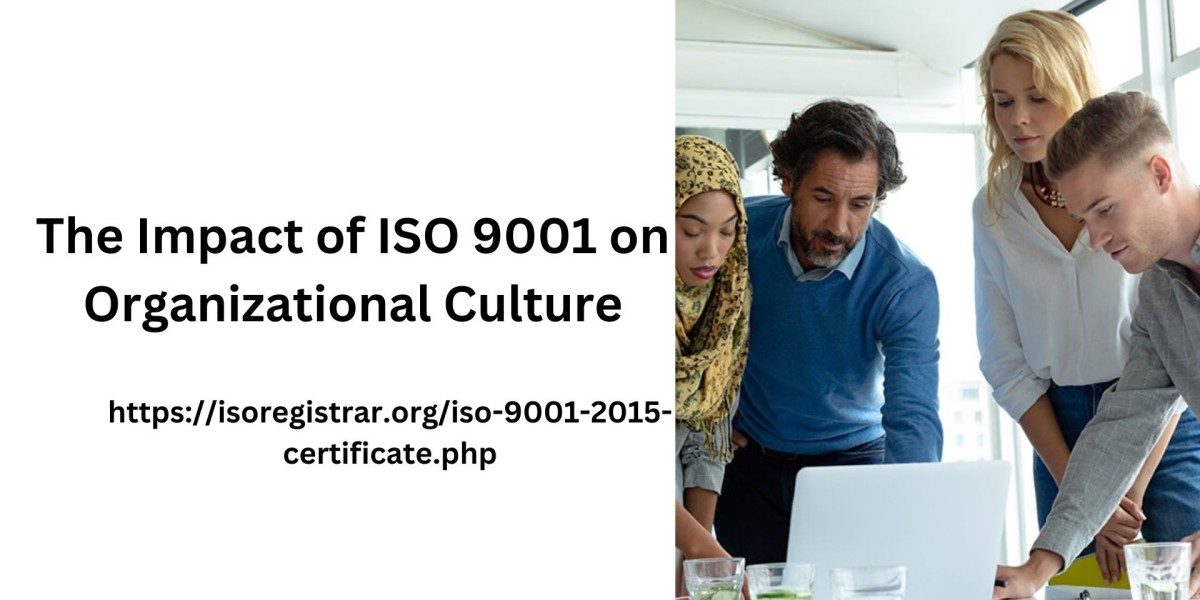Introduction
ISO 9001 certification, the internationally recognized standard for Quality Management Systems (QMS), is renowned for enhancing product and service quality. However, its influence extends beyond operational metrics to significantly impact organizational culture. By establishing a framework for continuous improvement, customer satisfaction, and structured processes, ISO 9001 can transform the way an organization functions, fostering a culture that prioritizes quality, collaboration, and accountability. This article explores how ISO 9001 impacts organizational culture and the resulting benefits for organizations.
1. Fostering a Culture of Quality
ISO 9001 places a strong emphasis on maintaining high-quality standards across all operations. This focus on quality permeates every level of the organization, from top management to operational staff. The standard's requirements for documented procedures, performance measurement, and continuous improvement cultivate a culture where quality is a shared responsibility.
In a culture shaped by ISO 9001, quality becomes a core value rather than a mere compliance requirement. Employees at all levels are encouraged to take ownership of quality in their work, leading to heightened awareness and commitment to maintaining high standards. This cultural shift helps embed quality practices into daily operations and decision-making processes, ensuring that quality is consistently prioritized.
2. Promoting Continuous Improvement
A fundamental principle of ISO 9001 is the commitment to continuous improvement. The standard requires organizations to regularly assess their performance, identify areas for improvement, and implement corrective and preventive actions. This focus on ongoing enhancement fosters a culture where employees are encouraged to seek better ways of doing things and contribute to the organization's growth.
In such a culture, continuous improvement becomes ingrained in the organizational mindset. Employees are motivated to identify inefficiencies, suggest improvements, and innovate processes. This proactive approach to problem-solving and process enhancement creates a dynamic and agile organization capable of adapting to changing market conditions and customer expectations.
3. Enhancing Employee Engagement and Empowerment
ISO 9001 emphasizes the importance of clear roles, responsibilities, and training for employees. By defining these aspects and providing the necessary resources and support, the standard helps create a work environment where employees feel valued and empowered.
When employees have a clear understanding of their roles and responsibilities, they are more likely to take ownership of their tasks and contribute to the organization's success. ISO 9001's focus on competence and training ensures that employees have the skills and knowledge needed to perform their roles effectively, leading to increased job satisfaction and engagement. Empowered employees who feel confident in their abilities are more likely to be motivated, productive, and committed to the organization's goals.
4. Encouraging Collaboration and Teamwork
ISO 9001 promotes a process-based approach to quality management, which involves coordinating and integrating various functions and departments to achieve common objectives. This approach encourages collaboration and teamwork across the organization.
In an ISO 9001-driven culture, departments and teams work together to ensure that quality requirements are met and processes are optimized. The standard's emphasis on effective communication, documentation, and cross-functional collaboration fosters an environment where information is shared openly, and teams work together to address quality issues and improve processes. This collaborative culture enhances organizational efficiency and helps build strong relationships among employees.
5. Establishing a Customer-Centric Culture
ISO 9001 places a strong emphasis on understanding and meeting customer requirements. The standard requires organizations to gather and analyze customer feedback, monitor customer satisfaction, and address customer complaints. This focus on customer needs helps create a culture that prioritizes customer satisfaction and drives efforts to deliver value to clients.
In a customer-centric culture, employees are trained to understand the importance of meeting customer expectations and are encouraged to seek ways to enhance the customer experience. This shift in focus helps align organizational goals with customer needs, leading to improved service delivery, stronger customer relationships, and increased loyalty.
6. Instilling a Sense of Accountability
ISO 9001 requires organizations to establish clear processes and procedures, document their activities, and monitor performance. This level of documentation and process control creates a culture of accountability, where employees understand the importance of adhering to established procedures and meeting performance expectations.
By defining roles, responsibilities, and performance metrics, ISO 9001 helps ensure that individuals are accountable for their contributions to the organization's quality objectives. This sense of accountability drives employees to take responsibility for their work, follow established processes, and contribute to the overall success of the organization.
7. Enhancing Leadership and Management Practices
ISO 9001 places significant emphasis on leadership and management commitment to the QMS. Top management is required to demonstrate leadership, support the QMS, and ensure that quality objectives are aligned with the organization's strategic direction.
This emphasis on leadership helps shape a culture where leaders are actively involved in promoting quality and driving improvement initiatives. Effective leadership fosters a positive work environment, motivates employees, and reinforces the organization's commitment to quality. Leaders who lead by example and support the QMS contribute to a culture of excellence and continuous improvement.
8. Building a Culture of Transparency
ISO 9001 requires organizations to document their processes, procedures, and performance metrics. This level of transparency ensures that information related to quality management is accessible and communicated effectively across the organization.
A culture of transparency helps build trust among employees, as they have clear visibility into how quality management processes work and how their performance contributes to organizational goals. Open communication about quality objectives, performance results, and improvement initiatives fosters an environment where employees feel informed and involved in the organization's quality journey.
9. Supporting Change Management
Implementing ISO 9001 often involves significant changes to processes, procedures, and organizational practices. The standard's focus on planned changes and risk management supports effective change management, helping organizations navigate transitions smoothly.
In a culture influenced by ISO 9001, change is approached systematically and strategically. Employees are engaged in the change process, and the impact of changes is carefully assessed to ensure minimal disruption to operations. This structured approach to change management helps organizations adapt to new challenges, embrace innovation, and continuously improve their processes.
10. Reinforcing Compliance and Risk Management
ISO 9001 requires organizations to identify and manage risks related to quality management. By incorporating a risk-based approach, the standard helps organizations proactively address potential issues and maintain compliance with regulatory requirements.
In a culture driven by ISO 9001, compliance and risk management are integral aspects of daily operations. Employees are trained to recognize and address risks, adhere to regulatory requirements, and follow established procedures to ensure compliance. This focus on risk management helps create a culture where quality and regulatory adherence are prioritized, reducing the likelihood of nonconformities and ensuring the organization's continued success.
Note: apply for iso 14001 certification through the iso portal
Conclusion
ISO 9001 has a profound impact on organizational culture, shaping the way organizations approach quality, collaboration, and continuous improvement. By fostering a culture of quality, continuous improvement, and customer focus, ISO 9001 drives positive changes in employee engagement, accountability, and leadership. The standard's emphasis on process optimization, risk management, and transparency helps build a resilient and agile organization capable of adapting to evolving challenges.
Implementing ISO 9001 not only enhances operational efficiency and customer satisfaction but also creates a work environment where employees are empowered, motivated, and committed to achieving organizational goals. As organizations embrace ISO 9001, they cultivate a culture that prioritizes excellence, collaboration, and ongoing improvement, contributing to long-term success and sustainability.









